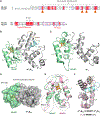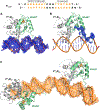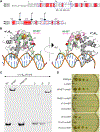Structural insights into the functional divergence of WhiB-like proteins in Mycobacterium tuberculosis
- PMID: 34171298
- PMCID: PMC8876573
- DOI: 10.1016/j.molcel.2021.06.002
Structural insights into the functional divergence of WhiB-like proteins in Mycobacterium tuberculosis
Abstract
WhiB7 represents a distinct subclass of transcription factors in the WhiB-Like (Wbl) family, a unique group of iron-sulfur (4Fe-4S] cluster-containing proteins exclusive to the phylum of Actinobacteria. In Mycobacterium tuberculosis (Mtb), WhiB7 interacts with domain 4 of the primary sigma factor (σA4) in the RNA polymerase holoenzyme and activates genes involved in multiple drug resistance and redox homeostasis. Here, we report crystal structures of the WhiB7:σA4 complex alone and bound to its target promoter DNA at 1.55-Å and 2.6-Å resolution, respectively. These structures show how WhiB7 regulates gene expression by interacting with both σA4 and the AT-rich sequence upstream of the -35 promoter DNA via its C-terminal DNA-binding motif, the AT-hook. By combining comparative structural analysis of the two high-resolution σA4-bound Wbl structures with molecular and biochemical approaches, we identify the structural basis of the functional divergence between the two distinct subclasses of Wbl proteins in Mtb.
Keywords: AT-hook; Wbl family; WhiB1; WhiB7; X-ray crystallography; antibiotic resistance; iron-sulfur cluster; transcription factor; σ(A)(4).
Copyright © 2021 Elsevier Inc. All rights reserved.
Conflict of interest statement
Declaration of interests The authors declare no competing interests.
Figures






Similar articles
-
Structural basis of DNA binding by the WhiB-like transcription factor WhiB3 in Mycobacterium tuberculosis.J Biol Chem. 2023 Jun;299(6):104777. doi: 10.1016/j.jbc.2023.104777. Epub 2023 May 2. J Biol Chem. 2023. PMID: 37142222 Free PMC article.
-
WhiB7, an Fe-S-dependent transcription factor that activates species-specific repertoires of drug resistance determinants in actinobacteria.J Biol Chem. 2013 Nov 29;288(48):34514-28. doi: 10.1074/jbc.M113.516385. Epub 2013 Oct 14. J Biol Chem. 2013. PMID: 24126912 Free PMC article.
-
Structural basis of transcriptional activation by the Mycobacterium tuberculosis intrinsic antibiotic-resistance transcription factor WhiB7.Mol Cell. 2021 Jul 15;81(14):2875-2886.e5. doi: 10.1016/j.molcel.2021.05.017. Epub 2021 Jun 24. Mol Cell. 2021. PMID: 34171296 Free PMC article.
-
WhiB-like proteins: Diversity of structure, function and mechanism.Biochim Biophys Acta Mol Cell Res. 2024 Oct;1871(7):119787. doi: 10.1016/j.bbamcr.2024.119787. Epub 2024 Jun 13. Biochim Biophys Acta Mol Cell Res. 2024. PMID: 38879133 Review.
-
The actinobacterial WhiB-like (Wbl) family of transcription factors.Mol Microbiol. 2018 Dec;110(5):663-676. doi: 10.1111/mmi.14117. Epub 2018 Oct 25. Mol Microbiol. 2018. PMID: 30179278 Free PMC article. Review.
Cited by
-
Analysis of whiB7 in Mycobacterium tuberculosis reveals novel AT-hook deletion mutations.Sci Rep. 2023 Aug 16;13(1):13324. doi: 10.1038/s41598-023-40152-2. Sci Rep. 2023. PMID: 37587174 Free PMC article.
-
A Feedback Regulatory Loop Containing McdR and WhiB2 Controls Cell Division and DNA Repair in Mycobacteria.mBio. 2022 Apr 26;13(2):e0334321. doi: 10.1128/mbio.03343-21. Epub 2022 Mar 31. mBio. 2022. PMID: 35357209 Free PMC article.
-
Structural basis of dual activation of cell division by the actinobacterial transcription factors WhiA and WhiB.Proc Natl Acad Sci U S A. 2023 Mar 14;120(11):e2220785120. doi: 10.1073/pnas.2220785120. Epub 2023 Mar 8. Proc Natl Acad Sci U S A. 2023. PMID: 36888660 Free PMC article.
-
Structural basis of transcription activation by the global regulator Spx.Nucleic Acids Res. 2021 Oct 11;49(18):10756-10769. doi: 10.1093/nar/gkab790. Nucleic Acids Res. 2021. PMID: 34530448 Free PMC article.
-
Binding to the Other Side: The AT-Hook DNA-Binding Domain Allows Nuclear Factors to Exploit the DNA Minor Groove.Int J Mol Sci. 2024 Aug 14;25(16):8863. doi: 10.3390/ijms25168863. Int J Mol Sci. 2024. PMID: 39201549 Free PMC article. Review.
References
-
- Alam MS, Garg SK, and Agrawal P. (2009). Studies on structural and functional divergence among seven WhiB proteins of Mycobacterium tuberculosis H37Rv. FEBS J. 276, 76–93. - PubMed
Publication types
MeSH terms
Substances
Grants and funding
LinkOut - more resources
Full Text Sources
Research Materials

